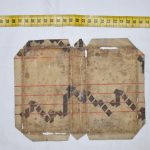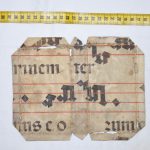Notated parchment leaf from the second volume of the so called „Bakócz” Gradual, one of the basic sources for medieval plainchant in Hungary. The Library of the Institute for Musicology purchased the fragment from Ágnes Handula on 2 January 1990. Zsuzsanna Szepesi, head of the library, had previously received the fragment from Tibor Csizmadia and it was examined by Janka Szendrei. See Szendrei, Graduale Strigoniense s. XV/XVI. Musicalia Danubiana 12. Budapest: HAS Institute for Musicology, 1993, 7, footnote 10: “C 1765 [olim]: fragment folio 202 X 75 mm, purchased from private ownership in 1990, with minor deficiencies. As the traces of incisions and folds show, it was used to bind a 134 X 75 mm booklet, which was then detached some time ago.”
The chants in the fragment belong to the Mass of the Common of Apostles. As is well known, the Bakócz Gradul does not prescribe a separate commune sanctorum after the Sanctorale but instead merges the common chants into the Sanctorale. However, the second volume of the codex also contains a special guide to the common mass propers of the saints: a list of chants in which the folio number next to the incipit refers to the first notated occurrence of the piece (see f. II, 121r–122v). The common chants of the Apostles are also included in the Sanctorale. Janka Szendrei was able to identify the exact location of the fragment in the main corpus. According to this, the chants here must have been inscribed for the first feast of the Apostles in the Kalendar, i.e. the Mass of the Apostles Simon et Iudas on 28 October. Folios 3 and 4 are missing from the second volume, which confirms that the piece in question fills this gap: it comes presumably from f. 4.
Gabriella Gilányi



